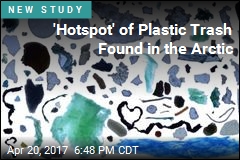Pollution is now as dense in the northernmost ocean as it is in the Atlantic and Pacific.
From an Article by Robinson Meyer, The Atlantic Monthly, April 20, 2017
The Arctic Ocean is small, shallow, and—most importantly—shrouded. Unlike the other large oceans of the world, it is closely hemmed in by Asia, Europe, and North America, with very few watery entrances in and out. Some oceanographers call it the “Arctic Mediterranean Sea,” a nod both to its between-the-terra-ness and its similarity to that smaller ocean.
Often, that remoteness has played to its ecological advantage. Very few ships pass through the area (with all their attendant pollution and environmental disruption), at least compared to nearby waterways like the Bering Sea. It also helps that much of the Arctic freezes over every winter.
But a paper released this week in Science Advances argues that its location is now harming it. The first survey of the region has found that roughly 300 billion pieces of floating plastic, most of them tiny but visible to the unaided eye, have clogged the planet’s northernmost sea. The plastic, having been carried to the pole over decades, now has very few ways out.
In other words, the Arctic Ocean has become the Northern Hemisphere’s “dead end” for floating plastic.
“Our data demonstrate that the marine plastic pollution has reached a global scale after only a few decades using plastic materials,” said Andrés Cózar Cabañas, a biologist at the University of Cádiz. It is, he said, “a clear evidence of the human capacity to change our planet. This plastic accumulation is likely to grow further.”
The survey was carried out while the research vessel Tara circumnavigated the pole in late 2013. The same Tara cruise also surveilled local plankton populations and observed the aurora.
It found a couple key differences in how plastic pollution works in the Arctic. To the south, in the Atlantic and the Pacific Oceans, plastic tends to accumulate in enormous subtropical “trash patches.” While these are not the dense and churning gyres of garbage that many people imagine, they can be accurately described as parts of the ocean with a lot of garbage in them. In a way, they’re like the asteroid belt, an otherwise void place in the world-ocean where plastic is much more likely to accumulate.
The Arctic does not so much have trash patches inside it; it is giant trash patch. The Arctic Ocean has about the same median density of plastic as the Atlantic and Pacific do. But unlike in the southern oceans, where plastic has unevenly congregated in certain areas, it has spread itself throughout the entirety of the Arctic.
Sometimes, though, it is quite dense: In the seas north of Iceland and western Russia, there are hundreds of thousands of pieces of plastic per square kilometer.
Martha Buckley, an oceanographer at George Mason University, agrees with the authors that plastic is not coming from the Arctic itself. This is “intuitive,” she writes: Few people live around that ocean’s coast, there is little ship traffic there, and most of the plastic is tiny enough that it seems to have spent several years in the ocean. (The paper’s authors estimate that it takes one to three years for plastic from the North Atlantic to make it to the Arctic.)
“It is pretty clear that this plastic has been transported by ocean currents. How the plastics are entering the Arctic is not as clear,” she told me in an email. The paper, for instance, doesn’t discuss transport through the ocean’s vertical currents. Over the last few years, research has suggested that gyres in the subtropics and subpolar regions are linked by deeper currents.
Ocean currents matter because they’ll help researchers learn if the plastic is trapped in the Arctic permanently or whether it will eventually work its way out. Other scientists are still trying to come up with solutions to the world’s long-term plastic problem. In the meantime, says Cabañas, the only way to fix the problem is to mitigate its scale. Countries and coastal communities should work harder to keep plastic from winding up in the ocean.
“We should properly manage the plastic waste at its source,” he told me. “Once the plastic enters the ocean, its destination and impacts are uncontrollable.”


{ 1 comment… read it below or add one }
Sea trash traps face doubts
By Erik Stokstad, Science, May 19, 2017:
Vol. 356, Issue 6339, pp. 671
Summary
An ambitious nonprofit has announced new plan to sweep up plastic litter circulating in a “garbage patch” in the remote North Pacific.
The Ocean Cleanup, based in Delft, the Netherlands, intends to launch a fleet of drifting trash collectors with booms that would funnel trash into central tanks, which ships would empty.
Some experts and environmentalists have doubts. They say collecting trash closer to shore would be more cost effective, and they worry the project will distract from less glamorous efforts to keep plastic out of the sea in the first place.
The Ocean Cleanup, which has raised $31.5 million in donations, originally planned to deploy a 100-kilometer-long arc of booms and secure the unit to the sea bed some 5 kilometers down.
But on 11 May, the group unveiled a revised blueprint that calls for up to 50 unmoored collectors, each just 1 or 2 kilometers long. They will be cheaper and faster to build, and they will collect more trash.
The target is to start production in early 2018.